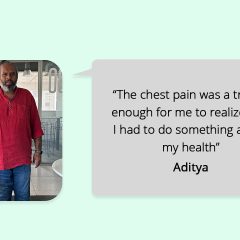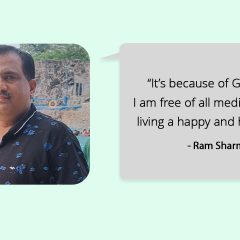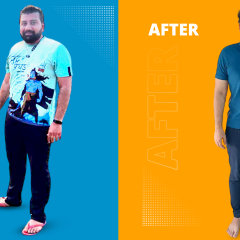
“I don’t want that explosion in my head, my father used to have,” says Ramesh N, 18 year old BE student when he came to my OPD after a severe headache of 5-6 hours. He was upset since he had his exams in a few days and he was not able to concentrate due to the throbbing pain. We all have visited physicians many times with the complaint of headache. Out of all the primary and secondary causes, migraine is the 2nd most common cause of headache amongst all.
Migraine is common in childhood, adolescence and early adulthood. It is ignored many times by parents and teachers assuming it as a reason to avoid studies or work. Migraine is benign episodic, syndrome of headache associated with other symptoms of neurological dysfunction. Most of the people have a positive family history of migraine.
A migraine attack can last anywhere from 4 to 72 hours. It is difficult to predict as to when a migrane attack will occur. However, one can predict the pattern of each attack as there are well defined stages. Once you know the stages of migraine and a proper history is given to the doctor, a diagnosis for migraine can be reached and medication can be taken to reduce the intensity or frequency of attacks.
Prodormal Phase: It includes certain physical or mental changes like mood changes, feeling thirsty, tiredness etc. It may last a few minutes or hours.
Aura Phase: It includes a wide range of neurological symptoms like changes in the sight like dark spots, colored spots, zigzag lines, numbness, weakness, dizziness, vertigo, speech changes, confusion might also occur before headache.
Attack Phase: Headache normally starts behind the eyes, is mostly severe and sometimes unbearable. Typically it is throbbing. It is unilateral but, can be bilateral as well. One may feel nauseated or might vomit in this stage. People generally also become sensitive to light and sound.
Postdromal Phase: Most of the attacks slowly fade away but, some stop suddenly after crying or sleeping for a while. It can take hours for many people to restore or days for that feeling to disappear. It is like a disturbing hangover.
Simplified diagnostic criterion: Repeated attacks of headaches lasting for 4-7 hours without physical examination & neurological investigation and no other cause found.
- Unilateral pain
- Throbbing
- Aggravated by movement
- Nausea/ vomiting
- Photphobia/ phonophobia
One can never be sure as to when the next episode would occur. However, many things including lifestyle changes can be done to either prevent an attack or reduce the frequency.
- Identifying and avoiding triggers is one of the most important ways to avoid an attack.
- Research shows that foods like nuts, cheese, citrus foods, chocolates, hot and spicy food, fermented, sour foods, alcohol and smoking can trigger a migraine attack.
- Untimely meals, irregular sleeping patterns which result in lack of sleep, excessive intake of processed or junk food, overthinking, extended exposure to laptops, mobile phones can all be responsible for triggering an attack.
- Increased exposure to direct sunlight is known to cause an attack. If sun exposure cannot be decreased or stopped, one must wear glasses and have to protect oneself. One must also be aware of strong odours and changes in weather.
- Being constantly acidic or constipated will always make you prone for repeated attacks.
A lifestyle change with proper sleeping hours, adequate water and the right food intake along with minimum 30minutes exercise will cause wonders in the management of Migraine.
- Certain yoga postures are extremely beneficial for migraine. Some of these are moon salutation, boat pose, bow pose (dhanurasan), spinal twist (matsyendrassana), tree pose and standing on toes.
- Meditation puts your mind at ease and reduces stress levels which brings a balance in one’s being.
- Pranayam (breathing exercises) has a long term impact in maintaining good health.
- 5 drops of brahmi ghee in each nostrils sometimes helps relieve the pain.
- During an attack it is best that you confine yourself to a closed dark room to avoid any loud sounds and excess light.
- You can also try tying a scarf or dupatta around your head if the pain is too much. Place some eye cubes wrapped in a towel on your eyes.
- Medicines are available which can stop the aura from progressing to an attack, otherwise painkillers may be used to decrease the eye pain and headache during the attack. Kindly consult your Doctor before popping any form of drug.
On a positive note your migraines can change over time for the better and it has been seen that the severity of the attacks tends to go down post early adulthood. One can opt for a healthy lifestyle which has been shown to not only reduce the intensity of each attack but, also the frequency.






